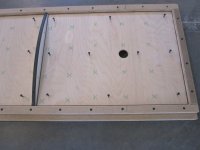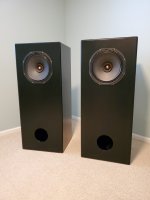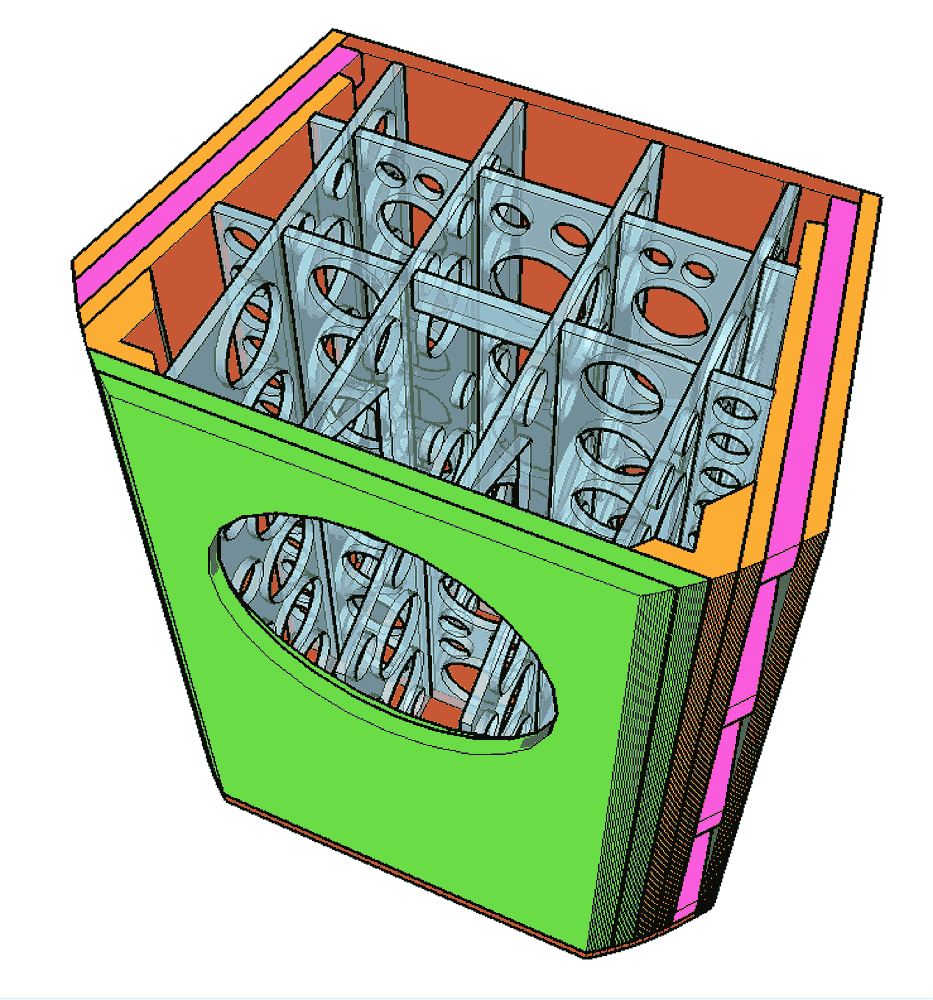Greetings! Thought I'd post the details of a full range cabinet build I completed several years ago. The drivers are the Audio Nirvana cast 12's in the recommended cabinet volume of 5.6 cubic feet. Something I tried was to use constrained layer damping on the interrior of the 3/4" plyron. This came about because I came across a few gallons of urethane sealant. I applied this with a notched trowel and pressed down 3/16" Baltic birch plywood, supported by protruding screws, until the sealant set up. I increased the dimensions of the Common Sense Audio's cabinet plans, to maintain the 5.6 volume. The thread inserts worked out well, using 10-24 brass screws. The bracing is solid core 1/2' thick Formica. Other than the recommended fiberglass batts, I lined the rest with 1/8" felt. Needless to say, you can't hear these boxes! I have loved these speakers over the years but also went on to electrostatics, infinite baffle sub, DML's, etc. I'll be retiring and moving/paring down in the next year, so likely will put them on the swap page. Pictures attached.
Attachments
-
 1.1.JPG496.2 KB · Views: 221
1.1.JPG496.2 KB · Views: 221 -
 1.JPG481.6 KB · Views: 227
1.JPG481.6 KB · Views: 227 -
 3.JPG380.2 KB · Views: 200
3.JPG380.2 KB · Views: 200 -
 4.JPG336.2 KB · Views: 207
4.JPG336.2 KB · Views: 207 -
 5.JPG372.4 KB · Views: 218
5.JPG372.4 KB · Views: 218 -
 6.1.JPG339.2 KB · Views: 222
6.1.JPG339.2 KB · Views: 222 -
 6.JPG277.7 KB · Views: 214
6.JPG277.7 KB · Views: 214 -
 7.JPG325.6 KB · Views: 215
7.JPG325.6 KB · Views: 215 -
 8.JPG386.4 KB · Views: 208
8.JPG386.4 KB · Views: 208 -
 9.1.JPG490.4 KB · Views: 224
9.1.JPG490.4 KB · Views: 224 -
 9.JPG308.4 KB · Views: 231
9.JPG308.4 KB · Views: 231 -
 10.1.JPG507.8 KB · Views: 229
10.1.JPG507.8 KB · Views: 229 -
 10.JPG327 KB · Views: 222
10.JPG327 KB · Views: 222 -
 11.JPG474.8 KB · Views: 225
11.JPG474.8 KB · Views: 225 -
 12.JPG260.4 KB · Views: 251
12.JPG260.4 KB · Views: 251 -
 13.jpg355.1 KB · Views: 356
13.jpg355.1 KB · Views: 356 -
 14.jpg283.4 KB · Views: 254
14.jpg283.4 KB · Views: 254 -
 15.jpg378.7 KB · Views: 251
15.jpg378.7 KB · Views: 251 -
 16.jpg399.8 KB · Views: 265
16.jpg399.8 KB · Views: 265 -
 17.jpg250.1 KB · Views: 225
17.jpg250.1 KB · Views: 225
The vent is 6" diameter. The plans from Dave Dicks at Common Sense Audio called for no bracing, and with the effective 1" thick walls, nothing moves in these cabinets. This was my first experience with full range drivers - to my ears they sound great. Compared to a three way speaker, they are a little beamy, but not at all compared to my stats! The bass is not boomy at all. They really don't need a sub, but since I have one, I like it to support the lowest octave. I'm driving them with a vintage Onkyo 100 wpc integrated - way more than necessary. They are very efficient - I'd like to hear them with a tube amp.
If what i asked was correct, then the curve at the top represents what the simulated response of your loudspeaker. The other 2 lines are (close) to a decent reflex, and right next to it, with the vent closed off.

David dicks knows little about speaker design. He got himself so lathered up many years ago here as he was severely criticized (rightly) for his lack of understanding, and did a bunch of stuff that got him banned.
1" material is not near thick enuff (steel might suffice) for an enclosure that size. This one is smaller, and naturally more rigid,

Of you like your loudspeakers now, there is a lot of room for improvement, and they will get better. Try sealing the vent to start. Even partially (stick a sweater in the vent). They will also take some time to break in, hopefully the ripple trail of resonances reduces overtime.
dave
David dicks knows little about speaker design. He got himself so lathered up many years ago here as he was severely criticized (rightly) for his lack of understanding, and did a bunch of stuff that got him banned.
1" material is not near thick enuff (steel might suffice) for an enclosure that size. This one is smaller, and naturally more rigid,

Of you like your loudspeakers now, there is a lot of room for improvement, and they will get better. Try sealing the vent to start. Even partially (stick a sweater in the vent). They will also take some time to break in, hopefully the ripple trail of resonances reduces overtime.
dave
Last edited:
Dave, not sure you read through the entire post properly:
At any rate, I think the walls are more than stiff enough, using 1" thick material and those small ribs on the insides are actually quite effective, the biggest gripe would be that there's nothing to break up internal reflections. And I agree on the tuning part, one fix could be using a much longer port.
A bit over-the-top redundant to re-do those boxes when he's putting them up for sale.I have loved these speakers over the years but also went on to electrostatics, infinite baffle sub, DML's, etc. I'll be retiring and moving/paring down in the next year, so likely will put them on the swap page.
At any rate, I think the walls are more than stiff enough, using 1" thick material and those small ribs on the insides are actually quite effective, the biggest gripe would be that there's nothing to break up internal reflections. And I agree on the tuning part, one fix could be using a much longer port.
I should think so considering stiffness increases at the cube of thickness. Really? Seems like he's used way more damping than I would.
Member
Joined 2009
Paid Member
nicely done - speaker looks good
I have been enjoying something similar for many years: https://www.diyaudio.com/community/threads/a-bigun-the-audio-nirvana-super-15.217893/page-27
I have been enjoying something similar for many years: https://www.diyaudio.com/community/threads/a-bigun-the-audio-nirvana-super-15.217893/page-27
to re-do those boxes when he's putting them up for sale.
I missed that, the new owber will like the info so not in vain.
dave
I don't think you need to brace as much as Planet10 says, but it need at least some crossobraces. I build a similar box for the Fane 12-250TC (but better tuned) and did it like this. Wood is 18mm birch ply, braces are 27x27mm pine slats. The driver sits between 2 layers of 18mm plywood mounted to the plate on the back with roundovers on the front hole.
And the AN cabinets I heared were all not well tuned. I'm not a fan of those drivers but the best results i heared with those were custom design, not the standard AN designs.
And the AN cabinets I heared were all not well tuned. I'm not a fan of those drivers but the best results i heared with those were custom design, not the standard AN designs.
Attachments
Thanks Dave. This was in 2015 - I guess I took what looked like was a proven existing enclosure design by the manufacturer of the driver - didn't know of the CSA history or the extensive bracing I could have done. I sure would have, as I am somewhat of a purist/perfectionist and don't mind the extra expense or effort if it improves the results, even in the slightest way. I did try a blocked vent with some fiberglass batting but they just didn't sound as lively.If what i asked was correct, then the curve at the top represents what the simulated response of your loudspeaker. The other 2 lines are (close) to a decent reflex, and right next to it, with the vent closed off.
View attachment 1033097
Gabid dicks knows little about speaker design. He got himself so lathered up many years ago here as he was severely criticized (rightly) for his lack of understanding, and did a bunch of stuff that got him banned.
1" material is not near thick enuff (steel might suffice) for an enclosure that size. This one is smaller, and naturally more rigid,

Of you like your loudspeakers now, there is a lot of room for improvement, and they will get better. Try sealing the vent to start. Even partially (stick a sweater in the vent). They will also take some time to break in, hopefully the ripple trail of resonances reduces overtime.
dave
Attachments
Thanks, Bigun! I wish I had read about your journey before beginning mine!nicely done - speaker looks good
I have been enjoying something similar for many years: https://www.diyaudio.com/community/threads/a-bigun-the-audio-nirvana-super-15.217893/page-27
David Dicks knows little about speaker design.
As much as I've 'trashed' his box designs for good reason, in his defense he's using the early pioneer's alignments based on the tube amps of the day and available radio/recording gain BW, so with the right amp and maybe a high pass filter they should perform quite well.
Last edited by a moderator:
If what i asked was correct, then the curve at the top represents what the simulated response of your loudspeaker. The other 2 lines are (close) to a decent reflex, and right next to it, with the vent closed off.
I like your cabinet designs Dave.
Last edited by a moderator:
- Home
- Loudspeakers
- Full Range
- Audio Nirvana Cast 12 5.6 Build


